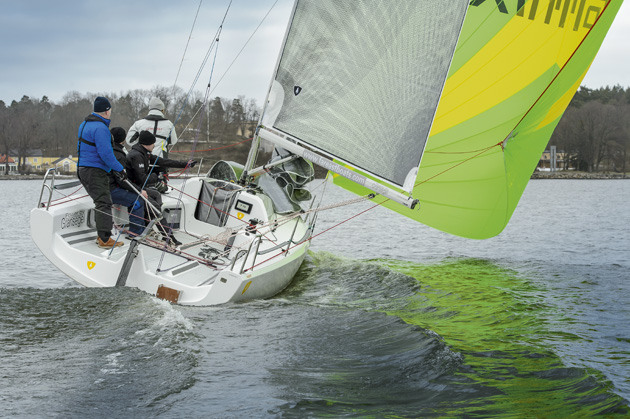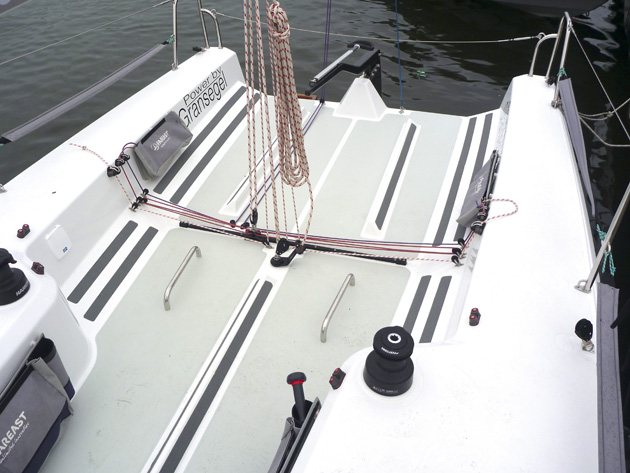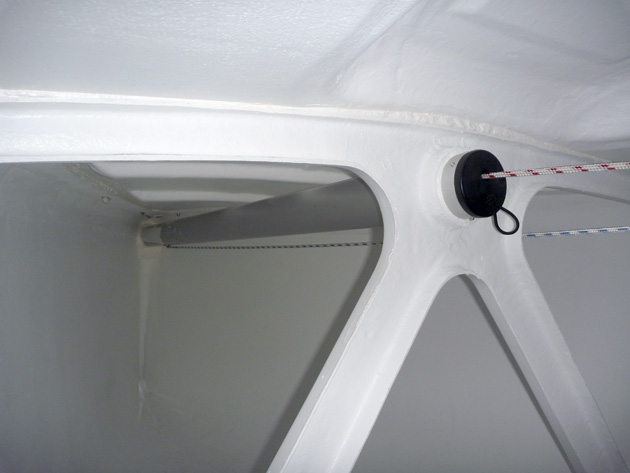This Chinese-built sportsboat is a simple, affordable and practical one-design, aimed at the inshore racing market. Matthew Sheahan steps aboard
Just over a year ago a little-known Chinese yard, the Shanghai Fareast Boats Co, made a big impression at the Düsseldorf boat show with a rocket red, all-carbon, downwind master-blaster.
Having moved from its familiar and modest stand of previous years, where it was pressed up against a wall in a corner of the show, the company placed its sportsboat-style Fareast 31R centre stage on a new stand in the middle of the hall.
But while she drew plenty of attention, she didn’t draw orders. One year later, after three had been built, just one was sold. The big red hope hadn’t materialised.
But Shanghai Fareast Boats isn’t a company that gives up easily. Indeed, although you might not have heard of them, many parents who have shelled out for a new Optimist have.
The company was founded in 2002 and shortly afterwards was licensed by the International Sailing Federation (ISAF) to build the Optimist. Today it is the biggest builder of the class in the world and, along with the 420 that it also builds, it pumped out 1,500 dinghies in total last year.
Yet despite the company’s ability to build big numbers to small tolerances and its experience of a couple of small keelboat models in its range, the 31R was clearly too ambitious a step. Undeterred and guided by the design team that had drawn the 31R, Simonis/Voogd, along with international sales and marketing consultant Mats Runström, the company made another attempt at producing an exciting, open cockpit one-design racer. But this time it took a different approach.
Whereas the 31R was full of carbon with a €108,000 price tag to match, the only carbon in the 28R is in the keel fin and rudder blade. Elsewhere she’s a straightforward vacuum-infused, glass foam sandwich with a price tag around one-third that of her flashy red sistership.
Yet dropping the price hasn’t meant a commensurate drop in quality – far from it. In fact, she’s really pretty well-built throughout, something that was easy to see in the empty interior. I had a good rummage around the shell-like accommodation, where a tidy bag and some non slip were the only furnishings, and I was impressed. She’s clean, tidy and with no sharp edges – there are plenty of boats on the market at twice the price and half the quality of finish.
Aimed at the inshore market
Intended as a simple, affordable and practical one-design, she is aimed at the inshore racing market and nothing else. Her open cockpit, fractional rig, retractable bowsprit and contemporary dreadnought bow means that she’s every bit the modern sportsboat in a size range that is starting to take off. Yet she’s a much simpler boat all round than some of her competition in the sub-30ft field.
For starters, her deck layout is a modest affair; the jib cars are on pin-stop tracks rather than having lines to haul the cars back and forth. Most of her control lines run over the deck rather than under it and rope tails are stowed away in cockpit rope bags as you’d expect rather than disappearing below deck through individual tidy holes.
Her sail plan is more modest too than, say, the grunty Farr 280, and the asymmetric kite is launched from the offset companionway out of a simple kite bag rather than through a chute affair on the foredeck. She’s basic in her spec and conventional in her layout and as such is very easy to get to grips with.
The first thing you notice, though, as you take the helm is how large the rudder is by modern standards. If you’re more used to a rudder blade with the proportions of a bread knife and a finger-light sensitive feel, the rock solid feel of this chunky carbon blade is almost retro. Yet in the context of a boat designed to provide open-cockpit, dinghy-style, one-design fun across a wide range of abilities, that’s no bad thing.
No one likes their rudder to let go with no warning and this one certainly won’t; your arms will come out of their sockets first.
Impressed with her performance
For our trials in the centre of Stockholm, deep in the middle of winter (don’t ask), there was only 8-10 knots of breeze with the odd gust hitting 12 knots scurrying across billiard table flat water. Hardly a punishing test, but I was impressed with this boat’s performance. Even in this light breeze she picked up speed easily and quickly, regularly slipping along downwind at 8-9 knots with occasional bursts over 11 knots.
Like any boat with a large asymmetric kite she needs to be sailed pretty flat to unload the foils in order to let her off the lead. This is a doddle with the huge, powerful rudder. Indeed, fighting it simply puts the handbrake on and wears your arms out so there’s plenty of incentive not to. Upwind she slipped along at around 6.5 knots.
But uphill or down, she seemed to know her way and fell into the groove with ease. Controls were close to hand and everything worked. Furthermore, she’s well-balanced, easy to handle and has plenty of space to accommodate however many of your crew it takes to achieve the proposed crew weight limit of 450kg.
Among the few criticisms that I did have, comfort upwind for the helmsman was disappointing. A combination of narrow side decks and foot braces that were too close made life more uncomfortable than should be the case. Her builders are aware of this and looking into the possibility of moving the foot braces, which would help matters.
But apart from that and in the absence of a good pounding around a breezy racecourse, I can say there really is little else not to like about this boat, which will be a worry for builders such as J Boats and other more expensive machines.
Other advantages include a lifting keel, a slim max beam at 2.70m and a displacement of 1,360kg, which means that she can be towed easily behind a decent-sized car.
But the real clincher given all of the above is that she has a very attractive price tag that starts at US$38,000 ex works China. The company plans to build 150 this year. So far around 40 have been built, with 70 earmarked for countries outside China. So this time the company looks as if it might have struck the right formula.
Looking closer
So while the 28R will provide stiff competition in Europe and the USA for models costing twice that price and more, the overall effect could be a benefit to all racers by helping to build a new class of sub-30ft fast, open-cockpit racers for a broad range of pockets – which can only be a good thing.
A simple, spacious cockpit can cater for five crew easily, but the narrow side decks and position of the foot braces make the cockpit less comfortable for the helmsman
Pit area – this is simple to operate with the minimum of controls: pole in and out, kite and jib halyards, a kicker and a cunningham so no excuse to fumble
The mainsheet system comes standard with a coarse and fine-tune system with conventional traveller control line adjustments close to hand
Her dreadnought bow gives her a modern look. But the clever detail is the simple, centreline-mounted bowsprit
Below decks the alloy retractable bowsprit runs inside an alloy tube. Note the simple, but well-finished structure
No fancy below decks chainplates here, just simple stainless steel brackets for a set of conventional rigging screws
A large powerful rudder in carbon fibre gives heaps of grip long after your arms have come out of their sockets. Note the outboard bracket – there is no inboard engine
Specifications
LOA 8.55m/28ft 0in
Beam 2.75m/9ft 0in
Draught 1.70m/5ft 7in
Displacement 1,360kg/2,997lb
Sail area:
Upwind 44m2/474ft2
Downwind 115m2/1,238ft2
Price US$38,000 (£25,620) ex works, ex tax
Designed by Simonis/Voogd
Built by Shanghai Fareast Boats Co
This is an extract from a feature in Yachting World May 2015













